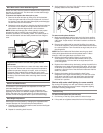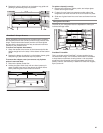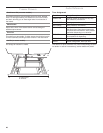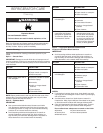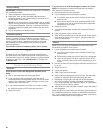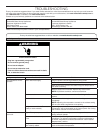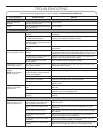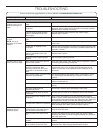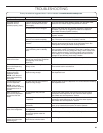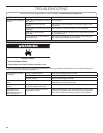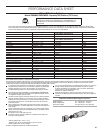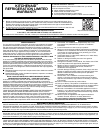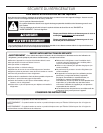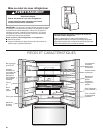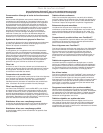
34
First try the solutions suggested here or visit our website at www.kitchenaid.custhelp.com.
If you experience Possible Causes Solution
Ice and Water (cont.)
The ice maker is not
producing ice or is not
producing enough ice.
(cont.)
An ice cube is jammed in the ice
maker.
Remove ice from ice maker with a plastic utensil.
A water filter is installed on the
refrigerator.
Remove the water filter and operate the ice maker. If ice volume
improves, then the filter may be clogged or incorrectly installed.
Replace filter or reinstall it correctly.
A reverse osmosis water filtration
system is connected to the cold
water supply.
This can decrease water pressure. See “Water Supply
Requirements” section.
The ice cubes are hollow
or small.
NOTE: This is an
indication of low water
pressure.
The water shut-off valve is not fully
open.
Turn the water shut-off valve to fully open.
There is a kink in the water source
line.
A kink in the line can reduce water flow. Straighten the water
source line.
A water filter is installed on the
refrigerator.
Remove filter and operate ice maker. If ice quality improves, then
the filter may be clogged or incorrectly installed. Replace filter or
reinstall it correctly.
A reverse osmosis water filtration
system is connected to the cold
water supply.
This can decrease water pressure. See “Water Supply
Requirements” section.
Questions remain regarding water
pressure.
Call a licensed, qualified plumber.
Off-taste, odor, or gray
color in the ice or water
Newly installed refrigerator requires
flush of water system.
Flush the water system. See “Water and Ice Dispensers” section
for water system flushing instructions.
Recently installed or replaced
plumbing connections. New
plumbing connections can cause
discolored or off-flavored ice and
water.
Discard the ice and wash the ice storage bin. Flush the water
system with 3 gal. (12 L) of water. Allow 24 hours for the ice
maker to make new ice and discard the first 3 batches of ice
produced.
Using a water supply connection type
other than recommended.
It is recommended to use copper tubing or KitchenAid
®
supply
line, Part Number 8212547RP. See “Connect to Water Line”
section.
The ice has been stored too long. Discard ice and wash ice storage bin. Allow 24 hours for ice
maker to make new ice.
The water has been stored too long. Dispense at least 1 qt (1 L) of water per week to maintain a fresh
supply.
Odor from stored food has
transferred to the ice.
Use airtight, moisture-proof packaging to store food.
There are minerals (such as sulfur)
in the water.
A water filter may need to be installed to remove the minerals.
There is a water filter installed on the
refrigerator.
Gray or dark discoloration in ice may indicate that the water
filtration system needs additional flushing. Flush the water system
after installing and before using a new water filter. See “Water and
Ice Dispensers” section for water filter flushing instructions.
The water filter needs to be replaced. Replace the disposable water filter at least every 6 months or
when indicated. See “Water Filtration System” section.
The water and ice
dispenser will not
operate properly.
The refrigerator is not connected to
a water supply or the water supply
shut-off valve is not turned on.
Connect the refrigerator to the water supply and turn the water
shut-off valve fully open.
There is a kink in the water source
line.
A kink in the water line can reduce water flow from the water
dispenser and result in hollow or irregular shaped ice. Straighten
the water source line.
The refrigerator has just been
installed.
Flush and fill the water system. See “Water and Ice Dispensers”
section.
The water pressure to the house is
not at or above 35 psi (241 kPa).
The water pressure to the house determines the flow from the
dispenser. See “Water Supply Requirements” section.
TROUBLESHOOTING



